ZHCSDV2 July 2015 ISO7820
PRODUCTION DATA.
- 1 特性
- 2 应用范围
- 3 说明
- 4 修订历史记录
- 5 Pin Configuration and Functions
-
6 Specifications
- 6.1 Absolute Maximum Ratings
- 6.2 ESD Ratings
- 6.3 Recommended Operating Conditions
- 6.4 Thermal Information
- 6.5 Power Rating
- 6.6 Electrical Characteristics, 5 V
- 6.7 Electrical Characteristics, 3.3 V
- 6.8 Electrical Characteristics, 2.5 V
- 6.9 Switching Characteristics, 5 V
- 6.10 Switching Characteristics, 3.3 V
- 6.11 Switching Characteristics, 2.5 V
- 6.12 Typical Characteristics
- 7 Parameter Measurement Information
- 8 Detailed Description
- 9 Applications and Implementation
- 10Power Supply Recommendations
- 11Layout
- 12器件和文档支持
- 13机械、封装和可订购信息
6 Specifications
6.1 Absolute Maximum Ratings(1)
| MIN | MAX | UNIT | ||||
|---|---|---|---|---|---|---|
| Supply voltage(2) | VCC1, VCC2 | –0.5 | 6 | V | ||
| Voltage | INx, OUTx | –0.5 | VCC + 0.5(3) | V | ||
| Output Current | IO | -15 | 15 | mA | ||
| Surge Immunity | 12.8 | kV | ||||
| Maximum junction temperature, TJ | 150 | °C | ||||
| Storage temperature, Tstg | –65 | 150 | °C | |||
(1) Stresses beyond those listed under absolute maximum ratings may cause permanent damage to the device. These are stress ratings only and functional operation of the device at these or any other conditions beyond those indicated under Recommended Operating Conditions is not implied. Exposure to absolute-maximum-rated conditions for extended periods may affect device reliability.
(2) All voltage values except differential I/O bus voltages are with respect to the local ground terminal (GND1 or GND2) and are peak voltage values.
6.2 ESD Ratings
| VALUE | UNIT | |||
|---|---|---|---|---|
| VESD | Electrostatic discharge | Human body model (HBM), per ANSI/ESDA/JEDEC JS-001, all pins (1) | ±6000 | V |
| Charged device model (CDM), per JEDEC specification JESD22-C101, all pins(2) | ±1500 | V | ||
(1) JEDEC document JEP155 states that 500-V HBM allows safe manufacturing with a standard ESD control process.
(2) JEDEC document JEP157 states that 250-V CDM allows safe manufacturing with a standard ESD control process.
6.3 Recommended Operating Conditions
| MIN | TYP | MAX | UNIT | ||||
|---|---|---|---|---|---|---|---|
| VCC1, VCC2 | Supply voltage | 2.25 | 5.5 | V | |||
| IOH | High-level output current | VCCO(2) = 5 V | -4 | mA | |||
| VCCO = 3.3 V | -2 | ||||||
| VCCO = 2.5 V | -1 | ||||||
| IOL | Low-level output current | VCCO = 5 V | 4 | mA | |||
| VCCO = 3.3 V | 2 | ||||||
| VCCO = 2.5 V | 1 | ||||||
| VIH | High-level input voltage | 0.7 x VCCI(2) | VCCI | V | |||
| VIL | Low-level input voltage | 0 | 0.3 x VCCI | V | |||
| DR | Signaling rate | 0 | 100 | Mbps | |||
| TJ | Junction temperature(1) | -55 | 150 | °C | |||
| TA | Ambient temperature | -55 | 25 | 125 | °C | ||
(1) To maintain the recommended operating conditions for TJ, see the Thermal Information table.
6.4 Thermal Information
| THERMAL METRIC | DW (16 Pins) | UNIT | ||
|---|---|---|---|---|
| RθJA | Junction-to-ambient thermal resistance | 84.7 | °C/W | |
| RθJC(top) | Junction-to-case(top) thermal resistance | 47.3 | ||
| RθJB | Junction-to-board thermal resistance | 49.4 | ||
| ψJT | Junction-to-top characterization parameter | 19.1 | ||
| ψJB | Junction-to-board characterization parameter | 48.8 | ||
| RθJC(bottom) | Junction-to-case(bottom) thermal resistance | n/a | ||
6.5 Power Rating
| VALUE | UNIT | |||
|---|---|---|---|---|
| PD | Maximum power dissipation by ISO7820 | VCC1 = VCC2 = 5.5 V, TJ = 150°C, CL = 15 pF, input a 50 MHz 50% duty cycle square wave |
100 | mW |
| PD1 | Maximum power dissipation by side-1 of ISO7820 | 20 | ||
| PD2 | Maximum power dissipation by side-2 of ISO7820 | 80 | ||
6.6 Electrical Characteristics, 5 V
VCC1 = VCC2 = 5 V ± 10% (over recommended operating conditions unless otherwise noted)| PARAMETER | TEST CONDITIONS | MIN | TYP | MAX | UNIT | ||
|---|---|---|---|---|---|---|---|
| VOH | High-level output voltage | IOH = –4 mA; see Figure 7 | VCCx(1) – 0.4 | VCCx – 0.2 | V | ||
| VOL | Low-level output voltage | IOL = 4 mA; see Figure 7 | 0.2 | 0.4 | V | ||
| VI(HYS) | Input threshold voltage hysteresis | 0.1 x VCCx(1) | V | ||||
| IIH | High-level input current | VIH = VCCx(1) at INx | 10 | μA | |||
| IIL | Low-level input current | VIL = 0 V at INx | -10 | ||||
| CMTI | Common-mode transient immunity | VI = VCCx(1) or 0 V; see Figure 9 | 70 | 100 | kV/μs | ||
| ICC1 | Supply current, DC Signal | DC signal: VI = 0 V (Devices with suffix F) , VI = VCCI(Devices without suffix F) | 0.9 | 1.3 | mA | ||
| ICC2 | 1.2 | 1.8 | |||||
| ICC1 | Supply current, DC Signal | DC signal: VI = VCCI (Devices with suffix F) , VI = 0 V(Devices without suffix F) | 3.2 | 4.6 | |||
| ICC2 | 1.3 | 2 | |||||
| ICC1 | Supply current | 1 Mbps | AC Signal: All channels switching with square wave clock input; CL = 15 pF |
2.1 | 3 | ||
| ICC2 | 1.3 | 2 | |||||
| ICC1 | Supply current | 10 Mbps | 2.1 | 3 | |||
| ICC2 | 2.3 | 3.8 | |||||
| ICC1 | Supply current | 100 Mbps | 2.7 | 3.3 | |||
| ICC2 | 11.9 | 15.3 | |||||
(1) VCCI = Input-side VCC; VCCO = Output-side VCC.
6.7 Electrical Characteristics, 3.3 V
VCC1 = VCC2 = 3.3 V ± 10% (over recommended operating conditions unless otherwise noted)| PARAMETER | TEST CONDITIONS | MIN | TYP | MAX | UNIT | ||
|---|---|---|---|---|---|---|---|
| VOH | High-level output voltage | IOH = –2 mA; see Figure 7 | VCCx(1) – 0.4 | VCCx – 0.2 | V | ||
| VOL | Low-level output voltage | IOL = 2 mA; see Figure 7 | 0.2 | 0.4 | V | ||
| VI(HYS) | Input threshold voltage hysteresis | 0.1 x VCCx(1) | V | ||||
| IIH | High-level input current | VIH = VCCx(1) at INx | 10 | μA | |||
| IIL | Low-level input current | VIL = 0 V at INx | -10 | ||||
| CMTI | Common-mode transient immunity | VI = VCCx(1) or 0 V; see Figure 9 | 70 | 100 | kV/μs | ||
| ICC1 | Supply current, DC Signal | DC signal: VI = 0 V (Devices with suffix F) , VI = VCCI(Devices without suffix F) | 0.9 | 1.3 | mA | ||
| ICC2 | 1.2 | 1.8 | |||||
| ICC1 | Supply current, DC Signal | DC signal: VI = VCCI (Devices with suffix F) , VI = 0 V(Devices without suffix F) | 3.2 | 4.6 | |||
| ICC2 | 1.3 | 2 | |||||
| ICC1 | Supply current | 1 Mbps | AC Signal: All channels switching with square wave clock input; CL = 15 pF |
2.1 | 3 | ||
| ICC2 | 1.3 | 2 | |||||
| ICC1 | Supply current | 10 Mbps | 2.1 | 3 | |||
| ICC2 | 2.3 | 3.8 | |||||
| ICC1 | Supply current | 100 Mbps | 2.5 | 3.2 | |||
| ICC2 | 8.9 | 11.5 | |||||
6.8 Electrical Characteristics, 2.5 V
VCC1 = VCC2 = 2.5 V ± 10% (over recommended operating conditions unless otherwise noted)| PARAMETER | TEST CONDITIONS | MIN | TYP | MAX | UNIT | ||
|---|---|---|---|---|---|---|---|
| VOH | High-level output voltage | IOH = –1 mA; see Figure 7 | VCCx(1) – 0.4 | VCCx – 0.2 | V | ||
| VOL | Low-level output voltage | IOL = 1 mA; see Figure 7 | 0.2 | 0.4 | V | ||
| VI(HYS) | Input threshold voltage hysteresis | 0.1 x VCCx(1) | V | ||||
| IIH | High-level input current | VIH = VCCx(1) at INx | 10 | μA | |||
| IIL | Low-level input current | VIL = 0 V at INx | -10 | ||||
| CMTI | Common-mode transient immunity | VI = VCCx(1) or 0 V; see Figure 9 | 70 | 100 | kV/μs | ||
| ICC1 | Supply current, DC Signal | DC signal: VI = 0 V (Devices with suffix F) , VI = VCCI(Devices without suffix F) | 0.9 | 1.3 | mA | ||
| ICC2 | 1.2 | 1.8 | |||||
| ICC1 | Supply current, DC Signal | DC signal: VI = VCCI (Devices with suffix F) , VI = 0 V(Devices without suffix F) | 3.2 | 4.6 | |||
| ICC2 | 1.3 | 2 | |||||
| ICC1 | Supply current | 1 Mbps | AC Signal: All channels switching with square wave clock input; CL = 15 pF |
2.1 | 3 | ||
| ICC2 | 1.3 | 2 | |||||
| ICC1 | Supply current | 10 Mbps | 2.1 | 3 | |||
| ICC2 | 1.8 | 2.7 | |||||
| ICC1 | Supply current | 100 Mbps | 2.4 | 3.2 | |||
| ICC2 | 7 | 9.1 | |||||
6.9 Switching Characteristics, 5 V
VCC1 = VCC2 = 5 V ± 10% (over recommended operating conditions unless otherwise noted)| PARAMETER | TEST CONDITIONS | MIN | TYP | MAX | UNIT | ||
|---|---|---|---|---|---|---|---|
| tPLH, tPHL | Propagation delay time | See Figure 7 | 6 | 10.7 | 16 | ns | |
| PWD(1) | Pulse width distortion |tPHL – tPLH| | 0.6 | 4.6 | ||||
| tsk(pp)(2) | Part-to-part skew time | 4.5 | ns | ||||
| tr | Output signal rise time | See Figure 7 | 2.4 | 3.9 | ns | ||
| tf | Output signal fall time | 2.4 | 3.9 | ||||
| tfs | Default output delay time from input power loss | Measured from the time VCC goes below 1.7 V. See Figure 8 | 0.2 | 9 | μs | ||
| tie | Time interval error | 216 - 1 PRBS data at 100 Mbps | 1 | ns | |||
(1) Also known as Pulse Skew.
(2) tsk(pp) is the magnitude of the difference in propagation delay times between any terminals of different devices switching in the same direction while operating at identical supply voltages, temperature, input signals and loads.
6.10 Switching Characteristics, 3.3 V
VCC1 = VCC2 = 3.3 V ± 10% (over recommended operating conditions unless otherwise noted)| PARAMETER | TEST CONDITIONS | MIN | TYP | MAX | UNIT | ||
|---|---|---|---|---|---|---|---|
| tPLH, tPHL | Propagation delay time | See Figure 7 | 6 | 10.8 | 16 | ns | |
| PWD(1) | Pulse width distortion |tPHL – tPLH| | 0.7 | 4.7 | ||||
| tsk(pp)(2) | Part-to-part skew time | 4.5 | ns | ||||
| tr | Output signal rise time | See Figure 7 | 1.3 | 3 | |||
| tf | Output signal fall time | 1.3 | 3 | ||||
| tfs | Default output delay time from input power loss | Measured from the time VCC goes below 1.7 V. See Figure 8 | 0.2 | 9 | μs | ||
| tie | Time interval error | 216 - 1 PRBS data at 100 Mbps | 1 | ns | |||
(1) Also known as Pulse Skew.
(2) tsk(pp) is the magnitude of the difference in propagation delay times between any terminals of different devices switching in the same direction while operating at identical supply voltages, temperature, input signals and loads.
6.11 Switching Characteristics, 2.5 V
VCC1 = VCC2 = 2.5 V ± 10% (over recommended operating conditions unless otherwise noted)| PARAMETER | TEST CONDITIONS | MIN | TYP | MAX | UNIT | ||
|---|---|---|---|---|---|---|---|
| tPLH, tPHL | Propagation delay time | See Figure 7 | 7.5 | 11.7 | 17.5 | ns | |
| PWD(1) | Pulse width distortion |tPHL – tPLH| | 0.7 | 4.7 | ||||
| tsk(pp)(2) | Part-to-part skew time | 4.5 | ns | ||||
| tr | Output signal rise time | See Figure 7 | 1.8 | 3.5 | |||
| tf | Output signal fall time | 1.8 | 3.5 | ||||
| tfs | Default output delay time from input power loss | Measured from the time VCC goes below 1.7 V. See Figure 8 | 0.2 | 9 | μs | ||
| tie | Time interval error | 216 - 1 PRBS data at 100 Mbps | 1 | ns | |||
(1) Also known as Pulse Skew.
(2) tsk(pp) is the magnitude of the difference in propagation delay times between any terminals of different devices switching in the same direction while operating at identical supply voltages, temperature, input signals and loads.
6.12 Typical Characteristics
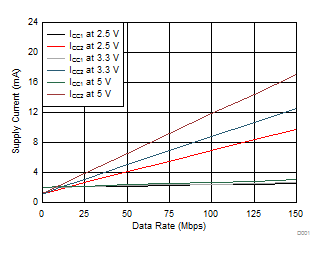
| TA = 25°C | CL = 15 pF |
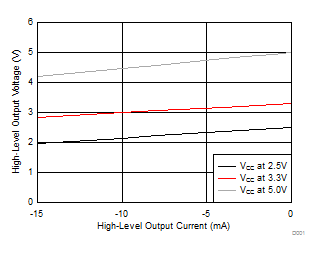
| TA = 25°C |
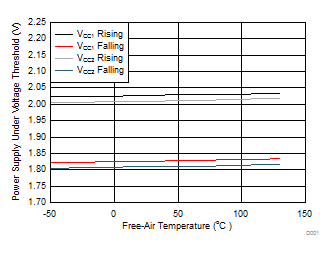
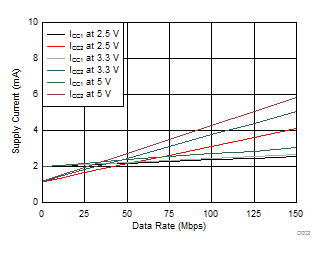
| TA = 25°C | CL = No Load |
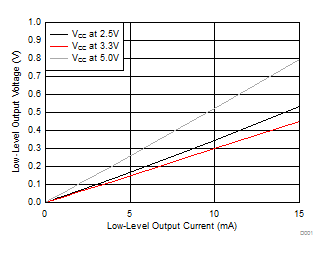
| TA = 25°C |
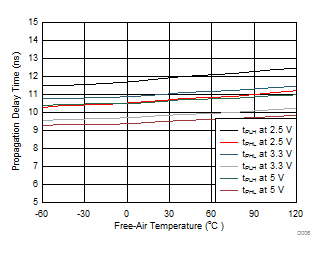
A.
Figure 6. Propagation Delay Time vs Free-Air Temperature